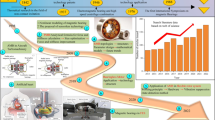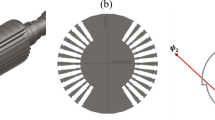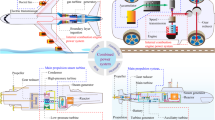Abstract
This paper aims to understand the bearing distributed–localized compound fault interaction in planetary bearing system. To reveal the compound faults coupling mechanism, the planetary gear bearing distributed–localized fault mathematical models were proposed to obtain the dynamic response in the presence of various planet bearing distributed–localized compound fault combinations. The instantaneous angular speed (IAS) measured from the carrier arm has been pre-processed with the consideration of different distributed–localized fault interactions and treated as inputs for the coherence estimation analysis, which has been used as a tool for the individual fault contribution quantification. Six representative bearing compound fault cases have been selected and the results show that the existence of the bearing compound faults interaction phenomenon can weaken the localized fault characteristic frequencies for the bearing fault diagnosis. However, the localized fault still contributes more than the distributed fault on the same bearing component on the condition that the fault magnitude is the same.













Similar content being viewed by others
Abbreviations
- δ ibj :
-
Bearing overall contact deformation
- x ibs :
-
Inner raceway displacement in the x direction
- x ibp :
-
Outer raceway displacement in the x direction
- y ibs :
-
Inner raceway displacement in the y direction
- y ibp :
-
Outer raceway displacement in the y direction
- Φ ibj :
-
Angular position
- k b :
-
Bearing contact stiffness
- γ ibj :
-
Contact state
- β j :
-
Localized fault switch
- C d :
-
Localized spall depth
- N i :
-
Inner race waviness number
- N o :
-
Outer race waviness number
- N b :
-
Rolling ball waviness number
- \({\Pi }_{p}\) :
-
Waviness magnitude
- x :
-
Input signal
- y :
-
Output signal
References
Boštjan D, Boškoski P, Juričić Đ (2016) Distributed bearing fault diagnosis based on vibration analysis. Mech Syst Signal Process 66:521–532
Harris TA (2001) Rolling bearing analysis, 4th Ed., Wiley
Karolina K et al (2022) Fault detecting accuracy of mechanical damages in rolling bearings. Machines 10(2):86
Su YT, Lin MH, Lee MS (1993) The effects of surface irregularities on roller bearing vibrations. J Sound Vib 165(3):455–466
Jiang Y, Huang W, Luo J et al (2019) An improved dynamic model of defective bearings considering the three-dimensional geometric relationship between the rolling element and defect area. Mech Syst Signal Process 129:694–716
Cao H, Niu L, Xi S, Chen X (2018) Mechanical model development of rolling bearing-rotor systems: a review. Mech Syst Signal Process 102:37–58
Singh S, Howard CQ, Hansen CH (2015) An extensive review of vibration modelling of rolling element bearings with localized and extended defects. J Sound Vib 357:300–330
Lundberg OE, Finnveden S, Björklund S et al (2015) A nonlinear state-dependent model for vibrations excited by roughness in rolling contacts. J Sound Vib 345:197–213
Sassi S, Badri B, Thomas M (2007) A numerical model to predict damaged bearing vibrations. J Vib Control 13(11):1603–1628
Ashtekar A, Sadeghi F, Stacke LE (2008) A new approach to modelling surface defects in bearing dynamics simulations. J Tribol 130(4):041103
Xue S, Howard I, Wang C (2019) The diagnostic analysis of the planet bearing faults using the torsional vibration signal. Mech Syst Signal Process 134:106304
Sawalhi N, Randall RB (2008) Simulation gear and bearing interactions in the presence of faults-Part I: the combined gear bearing dynamic model and the simulation of localized bearing faults. Mech Syst Signal Process 22(8):1924–1951
Wardle FP (1988) Vibration force produced by waviness of the rolling surface of thrust loaded ball bearing, Part 1: theory. Proc Inst Mech Eng 202(C5):305–312
Aktürk N, Uneeb M, Gohar R (1997) The effect of number of balls and preload on vibrations associated with ball bearings. ASME J Tribol 119(4):747–753
Choudhury A, Tandon N (1998) A theoretical model to predict vibration response of rolling bearings to distributed defects under radial load. ASME J Vib Acoust 120(1):214–220
Cao H, Su S, Jing X, Li D (2020) Vibration mechanism analysis for cylindrical roller bearings with single/multi defects and compound faults. Mech Syst Signal Process 144:106903
Jacopo CCM, Riccardo R, Marco C (2018) Experimental evidence of the speed variation effect on svm accuracy for diagnostics of ball bearings. Machines 6(4):48
Zhang X, Chen G, Hao T et al (2020) Rolling bearing fault convolutional neural network diagnosis method based on casing signal. J Mech Sci Technol 34:2307–2316
Xue S, Wang C, Howard I (2020) The diagnostic analysis of the fault coupling effects in planet bearing. Eng Fail Anal 108:104266
Wang PF, Xu HY, Ma H, Han HZ, Yang Y (2022) Effects of three types of bearing misalignments on dynamic characteristics of planetary gear set-rotor system. Mech Syst Signal Process 169:108736
Ye ZH, Wang LQ, Gu L, Zhang CW (2013) Effect of tilted misalignment on loading characteristics of cylindrical roller bearings. Mech Mach Theory 69:153–167
Liu J, Shi ZF, Shao YM (2017) A numerical investigation of the plastic deformation at the spall edge for a roller bearing. Eng Fail Anal 80:263–271
Schnabel S, Marklund P, Larsson R, Golling S (2017) The detection of plastic deformation in rolling element bearings by acoustic emission. Tribol Int 110:209–215
Xue S, Howard IM (2018) Torsional vibration signal analysis as a diagnostic tool for planetary gear fault detection. Mech Syst Signal Process 100:706–728
Petre S and Moses RL (2005) Spectral analysis of signals. Upper Saddle River, NJ: Prentice Hall.
Yang Y, Yang W, Jiang D (2018) Simulation and experimental analysis of rolling element bearing fault in rotor-bearing-casing system. Eng Fail Anal 92:205–221
Kahraman A (1994) Natural modes of planetary gear trains. J Sound Vib 173(1):125–130
Wang J, Liang Y, Zheng Y et al (2020) An integrated fault diagnosis and prognosis approach for predictive maintenance of wind turbine bearing with limited samples. Renew Energy 145:642–650
Fu C, Sinou JJ, Zhu WD, Lu K, Yang YF (2022) A state of the art review on uncertainty analysis of rotor systems. Mech Syst Signal Process 183:109619
Harris TA, Kotzalas MN (2007) Essential concepts of bearing technology, Taylor & Francis.
Randall RB, Antoni J (2011) Rolling element bearing diagnostics- a tutorial. Mech Syst Signal Process 25:485–520
Chegini SN, Bagheri A, Najafi F (2019) Application of a new EWT-based denoising technique in bearing fault diagnosis. Measurement 144:275–297
Liu Z, Zhang L, Carrasco J (2020) Vibration analysis for large-scale wind turbine blade bearing fault detection with an empirical wavelet thresholding method. Renew Energy 146:99–110
Li G, Tang G, Wang H, Wang Y (2019) Blind source separation of composite bearing vibration signals with low-rank and sparse decomposition. Measurement 145:323–334
Hoang DT, Kang HJ (2019) A survey on deep learning-based bearing fault diagnosis. Neurocomputing 335:327–335
Gunerkar RS, Jalan AK, Belgamwar SU (2019) Fault diagnosis of rolling element bearing based on artificial neural network. J Mech Sci Technol 33:505–511
Yuan X, Zhu YS, Zhang YY (2014) Multi-body vibration modelling of ball bearing rotor system considering single and compound multi-defects. Procee Inst Mech Eng, Part K: J Multi-body Dyn 228(2):199–212
Mogal P and Palhe SN (2019) Experimental investigations of multiple faults in ball bearing. In: Advances in Engineering Design, Springer, Singapore
Zhao M, Lin J, Xu XQ, Li XJ (2014) Multi-fault detection of rolling element bearings under harsh work condition using IMF-Based adaptive envelope order analysis. Sensor 14:20320–20346
Li YJ, Miao BG, Zhang WH, Chen P, Liu JH, Jiang XL (2019) Inspection of refined composite multiscale fuzzy entropy: application to detect localized defect of rolling element bearing. J Mech Sci Technol 33(1):1–12
Yu MY, Fang MH (2022) Feature extraction of rolling bearing multiple faults based on correlation coefficient and Hjorth parameter. ISA Trans 129(Part B):442–458
Zhao M, Jia X, Lin J, Lei Y, Lee J (2018) Instantaneous speed jitter detection via encoder signal and its application for the diagnosis of planetary gearbox. Mech Syst Signal Process 98:16–31
Fan Z, Li H (2015) A hybrid approach for fault diagnosis of planetary bearings using an internal vibration sensor. Measurement 64:71–80
Renaudin L, Bonnardot F, Musy O, Doray JB, Rémond D (2010) Natural roller bearing fault detection by angular measurement of true instantaneous angular speed. Mech Syst Signal Process 24:1998–2011
Acknowledgements
This work was supported by the National Natural Science Foundation of China under (52005377), National Key Research and Development Program of China under No. 2021YFC2203600, Natural Science Foundation of Shaanxi Province under (2020JQ290), Fundamental Research Funds for the Central Universities (JB210403, JB210404), Open Fund of Shaanxi Key Laboratory of Antenna and Control Technology.
Author information
Authors and Affiliations
Corresponding author
Additional information
Technical Editor: Jarir Mahfoud.
Publisher's Note
Springer Nature remains neutral with regard to jurisdictional claims in published maps and institutional affiliations.
Appendices
Appendix A
Planet bearing characteristic frequency for individual distributed fault and localized fault can be summarized here.
The planet bearing localized fault characteristic frequencies are:
The characteristic frequency of the outer race fault can be calculated as,
The characteristic frequency of the inner race fault can be calculated as,
The characteristic frequency of the rolling element fault can be calculated as,
The frequency fc is the carrier arm absolute rotating frequency and the planet gear absolute rotating frequency is,
The inner race absolute rotating frequency and the outer race absolute rotating frequency are,
The outer race relative rotating frequency becomes,
The rolling element cage rotating frequency becomes,
The rolling element rotating frequency becomes,
where Db is the diameter of a rolling element, Dp is the bearing pitch diameter, α is the contact angle.
The planet bearing distributed fault characteristic frequencies are:
For the inner raceway distributed fault, the resultant vibration peaks can be found in the positions of \(k{N}_{b}{f}_{cg}^{c} \left(k=\mathrm{1,2},3,\dots \right)\) regardless of the inner raceway fault orders.
For the outer raceway distributed fault, the resultant vibration peaks were found to be centered around the frequency of \(k{N}_{b}\left({f}_{oc}-{f}_{cg}^{c} \right) \left(k=\mathrm{1,2},3,\dots \right)\), which was further modulated by the frequency of \({f}_{cg}^{c}\) or \({f}_{o}\).
For the rolling ball distributed fault, the resultant vibration peaks were found to be centered around the frequency of \(2k{f}_{bc}^{c} \left(k=\mathrm{1,2},3,\dots \right)\), which was modulated by the frequency of \({f}_{cg}^{c}\).
Appendix B
For the rotary motion of the motor, the motion equation is,
For the motion of the sun gear, the differential equation is,
where Fspi is the normal contact force between the sun gear and the ith planet,
For the motion of the planet gears, the x and y components become,
where Frpi is the normal contact force between the ring gear and the ith planet,
For the motion of the ith planet gear bearing, the inner race can be modelled as a two degree of freedom system that has translational motion in x and y directions. The equation of motion of the inner race can be written as,
The outer race is modelled as a two degree of freedom system that has translational motion in the x and y directions. The equation of motion of the outer race can be written as,
The sprung mass is attached in the y direction. Its equation of motion can be written as,
where Fcpix and Fcpiy describe the interaction force between the ith planet bearing and the carrier arm in the x and y directions,
fibx, fiby describe the summation of the contact forces in the x- and x- directions for a ball bearing with nb balls and can be calculated as,
where kb is the combined contact stiffness between the rolling element and the races and γibj is the contact state. δibj and Φibj are the overall contact deformation as well as the angular position for the jth rolling element on the ith planet gear bearing, respectively, and they can be described as,
\({\Phi }_{\mathrm{ibo}}\) is the initial cage position and \({\upomega }_{\mathrm{ibc}}^{\mathrm{c}}\) is the cage speed measured in the rotating frame, which can be calculated as,
For the motion of the carrier arm, the motion equation is,
For the motion of the ring gear, the motion equation is,
For the rotary motion of the load, the motion equation is,
Rights and permissions
Springer Nature or its licensor (e.g. a society or other partner) holds exclusive rights to this article under a publishing agreement with the author(s) or other rightsholder(s); author self-archiving of the accepted manuscript version of this article is solely governed by the terms of such publishing agreement and applicable law.
About this article
Cite this article
Xue, S., Jin, Z., Wang, C. et al. The compound fault interaction analysis of the planet bearing system. J Braz. Soc. Mech. Sci. Eng. 44, 606 (2022). https://doi.org/10.1007/s40430-022-03892-2
Received:
Accepted:
Published:
DOI: https://doi.org/10.1007/s40430-022-03892-2




